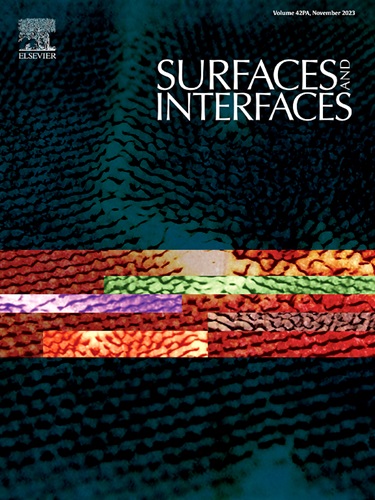Surface reconstruction of V2O5 boosting ammonium-ion storage
IF 5.7
2区 材料科学
Q2 CHEMISTRY, PHYSICAL
引用次数: 0
Abstract
Developing electrode materials for aqueous ammonium-ion batteries (AAIBs) has garnered significant attention recently. Owing to its poor intrinsic conductivity, sluggish electron transfer and ion diffusion kinetics, boosting the ammonium-ion storage properties of vanadium pentoxide (V2O5) remains significant challenge. In this work, we develop a surface reconstruction strategy to enhance the ammonium-ion storage of V2O5. V2O5 nanowires are firstly synthesized using a hydrothermal method and then these nanowires are etched by the insufficient dilute hydrochloric acid under the pumping filtration to obtain surface reconstruction of V2O5 (denoted as e-V2O5). Both experimental and theoretical calculation results manifest that the surface reconstruction strategy can improve the conductivity, kinetic and mass/ion transport of V2O5, resulting in enhancing its ammonium-ion storage. The e-V2O5 achieves the specific capacity of 160 mAh g−1 at 0.1 A g−1, which is much higher than that of V2O5 nanowires (116 mAh g−1) and even superior to the reported materials for ammonium-ion storage. The e-V2O5//PTCDI (3,4,9,10-perylene-bis(dicarboximide)) battery delivers E (energy density) of 112 Wh·kg−1 at P (power density) of 315 W·kg−1. This work not only proves the potential of e-V2O5 for applications to aqueous batteries, but also provides a surface reconstruction strategy for structural engineering of vanadium oxides with boosted ammonium-ion storage properties.

V2O5促进铵离子储存的表面重建
近年来,开发用于水铵离子电池(AAIBs)的电极材料备受关注。由于其固有电导率差,电子转移和离子扩散动力学缓慢,提高五氧化钒(V2O5)的氨离子存储性能仍然是一个重大挑战。在这项工作中,我们开发了一种表面重建策略来增强V2O5的铵离子储存。首先采用水热法合成V2O5纳米线,然后用不足的稀盐酸在泵送过滤下进行蚀刻,得到V2O5的表面重构(记为e-V2O5)。实验和理论计算结果都表明,表面重构策略可以提高V2O5的电导率、动力学和质量/离子输运,从而增强其铵离子的储存能力。在0.1 A g−1下,e-V2O5纳米线的比容量达到160 mAh g−1,远远高于V2O5纳米线的比容量(116 mAh g−1),甚至优于已有报道的铵离子存储材料。E - v2o5 //PTCDI(3,4,9,10-苝-双(二甲亚胺))电池在P(功率密度)为315 W·kg - 1时,E(能量密度)为112 Wh·kg - 1。这项工作不仅证明了e-V2O5在水性电池中的应用潜力,而且为提高铵离子存储性能的钒氧化物的结构工程提供了一种表面重建策略。
本文章由计算机程序翻译,如有差异,请以英文原文为准。
求助全文
约1分钟内获得全文
求助全文
来源期刊

Surfaces and Interfaces
Chemistry-General Chemistry
CiteScore
8.50
自引率
6.50%
发文量
753
审稿时长
35 days
期刊介绍:
The aim of the journal is to provide a respectful outlet for ''sound science'' papers in all research areas on surfaces and interfaces. We define sound science papers as papers that describe new and well-executed research, but that do not necessarily provide brand new insights or are merely a description of research results.
Surfaces and Interfaces publishes research papers in all fields of surface science which may not always find the right home on first submission to our Elsevier sister journals (Applied Surface, Surface and Coatings Technology, Thin Solid Films)
 求助内容:
求助内容: 应助结果提醒方式:
应助结果提醒方式:


